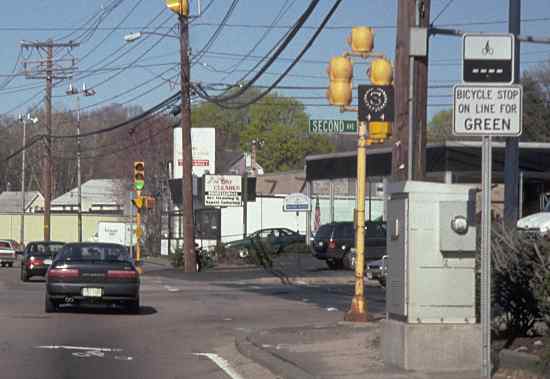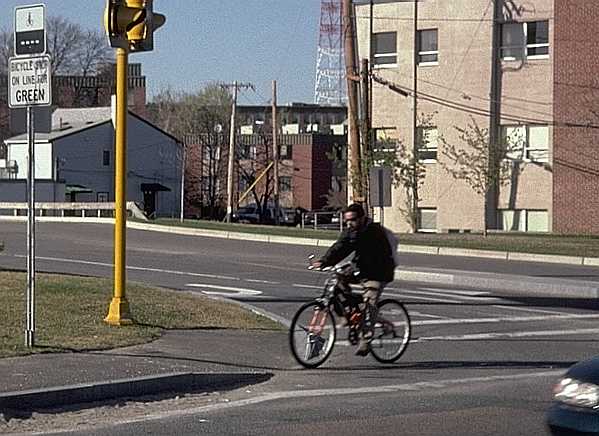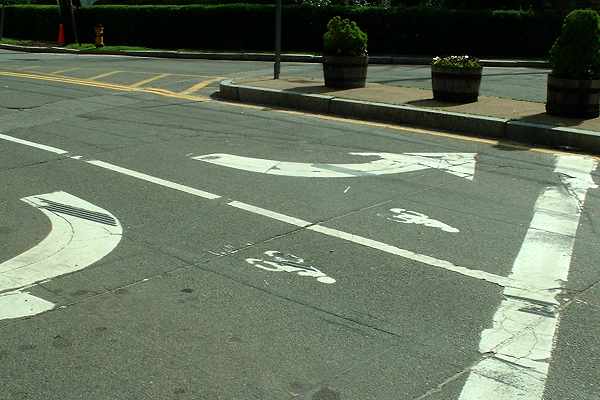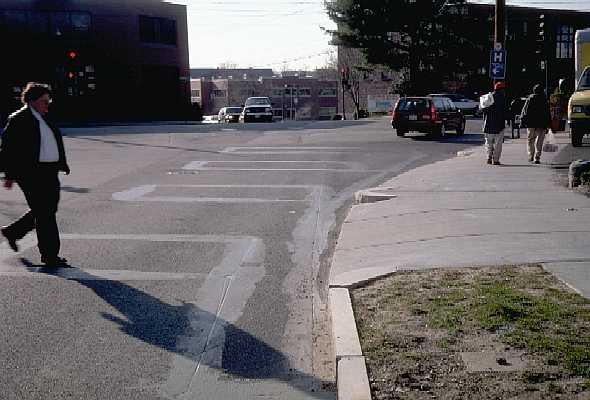Top: Home Page
Up: Table of Contents
Previous:
Next:
NONSTANDARDIZATION OF BICYCLE-SENSITIVE
ACTUATOR SIGN AND MARKING
IN MASSACHUSETTS
On August 21, 2004, cyclist Richard Amirault forwarded a message from one Richard
Harrington to the Massbike e-mail list, asking the following:
I was riding along on route 6 in Seekonk, MA the other day (on the shoulder as
usual) and came to a red light at a 4-way intersection. Pulled up behind
someone and noticed a sign on the side of the road reading "Bicycles stop on
green". What is that supposed to mean? How are you supposed to stop
on green (and why the hell would you want to)? Am I missing something?
|
An example of the type of installation in question.
Sign is at right, bicycle marking on pavement at lower left.
Highland Avenue, Needham, spring of 2001.

Paul Schimek, former President of the Massachusetts Bicycle Coalition, responded on
August 23:
These signs are supposed to help bicyclists get a green light. Since 1998 they have
been placed at every new traffic signal paid for by the Mass Highway Department, thanks to
MassBike's interventions. Unfortunately, due to errors in the specifications, the program
is worse than useless.
Most traffic signals use buried loops of wire to detect the presence of vehicles.
Depending on the location and time of day, the loop may be used to change the light to
green, to bring up a left arrow, to shorten or lenghthen a green, or to count traffic.
Some but not all installations are senstive to the amount of metal in a bicycle, if the
bicycle is over the most sensitive part of the loop, which is the right or left edge for a
rectangular loop. For more information, see
http://www.bikexprt.com/bicycle/actuator.htm
and
http://www.humantransport.org/bicycledriving/library/signals/green.htm
The 1998 MHD policy is intended to insure that there is a bicycle-sensitive loop and
that bicyclists know how to use it. It has failed:
The MHD sign is confusing. Many people think that "BICYCLE STOP ON
LINE FOR GREEN" means that bicyclists should stop when the signal is green. The
official Federal sign says "TO REQUEST GREEN WAIT ON [symbol of a person on a
bicycle with a vertical line]." That same symbol is supposed to be marked on the
pavement.
The MHD policy has failed to get symbols on the roadway. They told me
that their contractors were unable to paint something so small. Other places have figured
it out. Yet there has been no fix in the past 6 years.
The MHD policy has failed to insure that the new detectors are adjusted
to be bicycle-sensitive. Even if you know where to look and you find one, it may or may
not trip the signal.
The MHD policy specifies that only one of a series of loops need be
bicycle-sensitive. The positioning of this loop is crucial. The policy does not insure
that the loop will be placed where bicyclists should be depending on their intended
direction of travel at the intersection.
View the Massachusetts
specification (Microsoft Word document).
And you may also read another article about
actuator loops and how they work, or don't.
Contractors often aren't able to understand the specification. Sometimes the signs and
markings are placed in the wrong place, sometimes the markings aren't even placed over the
sensitive part of the loop, and more often than not, cities and towns fail to install the
specified type of loop at all -- see photos below. |
Sign facing away from traffic, also at Highland Avenue and
Second Avenue, Needham, 2001. Either the plans were wrong
or the contractor read them wrong. The sign
should have been facing the street that enters from the middle left of
the photo (note bicycle symbol behind bicyclist's rear wheel).

Markings on Cedarwood Avenue at Weston Street,
Waltham, September, 2005. Bicycle markings should be at the
center of each lane, over the center wire of the actuator
loop. These markings are neither. (Pavement cuts
for wires are visible as lines in pavement surface).

A related, pervasive problem is failure of local communities
to install bicycle-sensitive loops at all. Below, old-type dipole
loops, Derby Street at Waltham Sttreet, Newton, 2001.
Shortly after the photo was taken, they were paved over
and bicyclists couldn't even find them to try to trip the signal
by aligning the bicycle with the wire of a loop.





